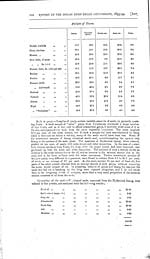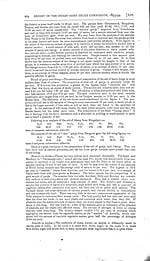Medicine - Drugs > Report of the Indian Hemp Drugs Commission, 1894-1895 > Volume III
(207) Volume 3, Page 203
Thumbnail gallery: Grid view | List view

REPORT BY MR. DAVID HOOPER, GOVERNMENT QUlNOLOGIST, MADRAS. 203
"The most recent and
complete analysis of hemp speds has been published by S.
Frankfurt
(Landw Versuchs. Stat. 43.143.182 Journ. Chem. Soc.,
March 1894, p. 113). This ex-
amination, it must be pointed out, was made upon European
seeds:—
|
Proteids |
18.63 |
||||||
|
Nuclein, &c. |
3.36 |
||||||
|
Lecithin |
0.68 |
||||||
|
Cholesterol |
3.07 |
||||||
|
Glycerides and free fatty acids |
30.92 |
||||||
|
Cane sugar and other coluble carbohydrates |
2.50 |
||||||
|
Crude fibre |
26.33 |
||||||
|
Soluble organic acids |
0.63 |
||||||
|
Ash |
5.55 |
||||||
|
Not determined |
11.03 |
||||||
The extracts of the seeds
do not reduce Fehling.s solution without previous boiling
with
an acid; the sugars found in the hemp drugs were therefore not
derived from the seeds..
The percentage of nitrogen (3.57) in the seeds is higher than that
obtained in the ganjas
and bhangs, a result which would be expected by any one having an
acquaintance with vege-
table physiology.
Sugar in hemp
drugs.—The occurrence of sugar does not seem to have been
noticed by
other investigators. It was detected first in the samples sold in
the local bazar at Ootaca-
mund, and as it was absent from some Bombay samples, and appearing
in traces in Bengal
ganjas, adulteration was suspected. But as sugar occurred in all
the Madras samples; and in
pretty uniform quantity, and in the cultivated leaves from Rajshahi
and the wild plants
from Assam and the Nilgiris, it could not be considered anything
else than a natural con-
stituent. The nature of the sugar, besides being amorphous and
allied to glucose in reducing
potassio-cupric tartrate, was not investigated. An extract of ganja
containing sugar, if pre-
pared with rectified spirit, would after a time separate into two
portions, a greenish-black
resinous mass, and a brownish soft substance of a liquorice-like
odour and sweetish taste; The
presence of saccharine matter would not be desirable in a medicinal
extract of Indian hemp
as it would dilute the active resinous matter; on the other hand,
if present, it could easily be
removed by washing with water.
Organic acids in
hemps.—There is no tancic acid in any of the hemp drugs. The
acid
removed from the aqueous solutions by means of lead acetate
resembled citric acid more than
anything else, but as a loss was experienced in separating this in
a state of purity, other acids
might have been removed in the mother-liquors. Oxalate of calcium
was present in all the
samples and accounted for the large quantity of calcium carbonate
present in the ashes.
The larger the amount of solid aqueous extract in the drug, the
higher was the proportion of
the organic acid; but this rule is interfered with when sugar
occurs in the extract. The
percentage of oxide of lead in the lead compound of the organic
acid ranged from 55 to 61
per cent. The colouring matter. of the extract was also removed by
load acetate, but
another substance giving a transient purplish colour with ferric
chloride was left in solution.
Nitrogen.—The
percentage of nitrogen ranged from 1.96 to 3.48 in the ganjas, and
from
1.91 to 3.17 in the samples of bhang. In the case of ganjas the
high percentage of nitrogen
is generally accompanied with a large percentage of resins, but
there are some remarkable ex-
ceptions to this rule, The best of the Madras samples, judging from
the yield of resins, do not
contain so much nitrogen as some Bombay samples inferior is rosin
contorss. The Ahmedna-
gar sample of the best quality and richest in resin contains the
lowest amount of nitrogen and
vice versa. The two samples of Sind and those of Nimar him;
the higher provontion of nitrogen
associated with the lower proportion of resin. The Naogaou ganjas
contained alkaloids and
ammonia in the aqueous solution of their spirit extracts. Ammonia
was not detected in. many
of the other samples, and was absent altogether where the nitrogen
was low. Ganja requires
high cultivation, and no doubt is Naogaon and Daggupad, where the
growth is well sup-
erintended, manure is largely used; Both the ganjas and bhangs
contsiu more nitrogen than
the average green fodder so extensively used. The crude fibre
contained a considerable amount
of nitrogen existing as insoluble albuminoid matter, as ammoniacal
fumes were given off each
time it was ignited.
The resins.—The
best gauge, of the resinous contents of the samples is to observe
the per-
centage of "ether extracts" in the foregoing tables; the direct
spirit extracts contain, as I
have pointed out, variable amounts of water-soluble matters in
addition to the resins. The
Kistna ganja is the best in Madras, and the Madras city sample from
Javadi hills is the
worst.
The Naogaon ganjas, as a
whole, are superior to the other supplies, with the ex-
ception of the Kistna sample; giving over 25 per cent, of resins.
It is strange that
in appearance as well as in composition the "first kind" of Sind
ganja imported from
Panvel should be inferior to the "second. kind" imported from
Sholapur. Another aspect
of the ganja trade is the difference in the composition of samples
said to come from the same
place. The Sholapur ganja, sold its Sind contains 21.14. percent.
of resins, while that from
Set display mode to: Large image | Zoom image | Transcription
Images and transcriptions on this page, including medium image downloads, may be used under the Creative Commons Attribution 4.0 International Licence unless otherwise stated. ![]()
| India Papers > Medicine - Drugs > Report of the Indian Hemp Drugs Commission, 1894-1895 > Volume III > (207) Volume 3, Page 203 |
|---|
| Description | Volume 3: Appendices. Miscellaneous. |
|---|---|
| Attribution and copyright: |
|




